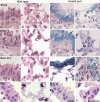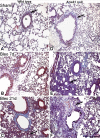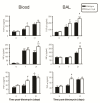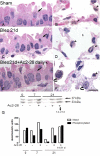Endogenous annexin A1 counter-regulates bleomycin-induced lung fibrosis
- PMID: 22011168
- PMCID: PMC3212807
- DOI: 10.1186/1471-2172-12-59
Endogenous annexin A1 counter-regulates bleomycin-induced lung fibrosis
Abstract
Background: The balancing functions of pro/anti-inflammatory mediators of the complex innate responses have been investigated in a variety of experimental inflammatory settings. Annexin-A1 (AnxA1) is one mediator of endogenous anti-inflammation, affording regulation of leukocyte trafficking and activation in many contexts, yet its role in lung pathologies has been scarcely investigated, despite being highly expressed in lung cells. Here we have applied the bleomycin lung fibrosis model to AnxA1 null mice over a 21-day time-course, to monitor potential impact of this mediator on the control of the inflammatory and fibrotic phases.
Results: Analyses in wild-type mice revealed strict spatial and temporal regulation of the Anxa1 gene, e.g. up-regulation in epithelial cells and infiltrated granulocytes at day 7, followed by augmented protein levels in alveolar macrophages by day 21. Absence of AnxA1 caused increases in: i) the degree of inflammation at day 7; and ii) indexes of fibrosis (assessed by deposition of hydroxyproline in the lung) at day 7 and 21. These alterations in AnxA1 null mice were paralleled by augmented TGF-β1, IFN-γ and TNF-α generation compared to wild-type mice. Finally, treatment of wild type animals with an AnxA1 peptido-mimetic, given prophylactically (from day 0 to 21) or therapeutically (from day 14 onward), ameliorated both signs of inflammation and fibrosis.
Conclusion: Collectively these data reveal a pathophysiological relevance for endogenous AnxA1 in lung inflammation and, more importantly, fibrosis, and may open new insights for the pharmacological treatment of lung fibrosis.
Figures







Similar articles
-
A prostacyclin analogue, iloprost, protects from bleomycin-induced pulmonary fibrosis in mice.Respir Res. 2010 Mar 20;11(1):34. doi: 10.1186/1465-9921-11-34. Respir Res. 2010. PMID: 20302663 Free PMC article.
-
Uridine supplementation exerts anti-inflammatory and anti-fibrotic effects in an animal model of pulmonary fibrosis.Respir Res. 2015 Sep 15;16(1):105. doi: 10.1186/s12931-015-0264-9. Respir Res. 2015. PMID: 26369416 Free PMC article.
-
The triterpenoid CDDO-Me inhibits bleomycin-induced lung inflammation and fibrosis.PLoS One. 2013 May 31;8(5):e63798. doi: 10.1371/journal.pone.0063798. Print 2013. PLoS One. 2013. PMID: 23741300 Free PMC article.
-
Interpreting Immunoregulation in Lung Fibrosis: A New Branch of the Immune Model.Front Immunol. 2021 Aug 20;12:690375. doi: 10.3389/fimmu.2021.690375. eCollection 2021. Front Immunol. 2021. PMID: 34489937 Free PMC article. Review.
-
The Multifaceted Role of Annexin A1 in Viral Infections.Cells. 2023 Apr 11;12(8):1131. doi: 10.3390/cells12081131. Cells. 2023. PMID: 37190040 Free PMC article. Review.
Cited by
-
Annexin A1 is elevated in patients with COPD and affects lung fibroblast function.Int J Chron Obstruct Pulmon Dis. 2018 Feb 5;13:473-486. doi: 10.2147/COPD.S149766. eCollection 2018. Int J Chron Obstruct Pulmon Dis. 2018. PMID: 29440885 Free PMC article.
-
The Protective Effects of Annexin A1 in Acute Lung Injury Mediated by Nrf2.Immun Inflamm Dis. 2025 Jan;13(1):e70111. doi: 10.1002/iid3.70111. Immun Inflamm Dis. 2025. PMID: 39807748 Free PMC article.
-
The Interactome of the Glucocorticoid Receptor and Its Influence on the Actions of Glucocorticoids in Combatting Inflammatory and Infectious Diseases.Microbiol Mol Biol Rev. 2016 May 11;80(2):495-522. doi: 10.1128/MMBR.00064-15. Print 2016 Jun. Microbiol Mol Biol Rev. 2016. PMID: 27169854 Free PMC article. Review.
-
Annexin-A1-Derived Peptide Ac2-26 Suppresses Allergic Airway Inflammation and Remodelling in Mice.Cells. 2022 Feb 22;11(5):759. doi: 10.3390/cells11050759. Cells. 2022. PMID: 35269381 Free PMC article.
-
Annexin A1: shifting the balance towards resolution and repair.Biol Chem. 2016 Oct 1;397(10):971-9. doi: 10.1515/hsz-2016-0180. Biol Chem. 2016. PMID: 27232634 Free PMC article. Review.
References
-
- Moore BB, Hogaboam CM. Murine models of pulmonary fibrosis. Am J Physiol Lung Cell Mol Physiol. 2008;294:L152–L160. - PubMed
Publication types
MeSH terms
Substances
Grants and funding
LinkOut - more resources
Full Text Sources
Other Literature Sources
Medical
Molecular Biology Databases
Research Materials
Miscellaneous

